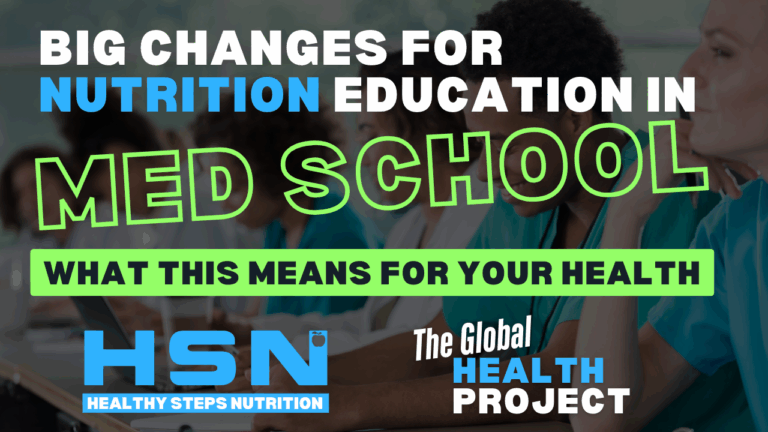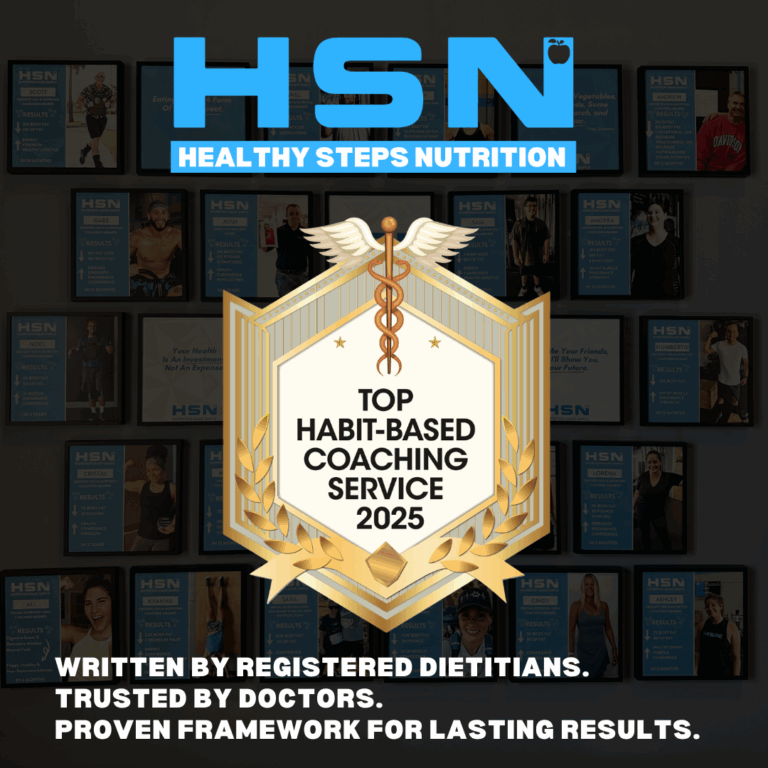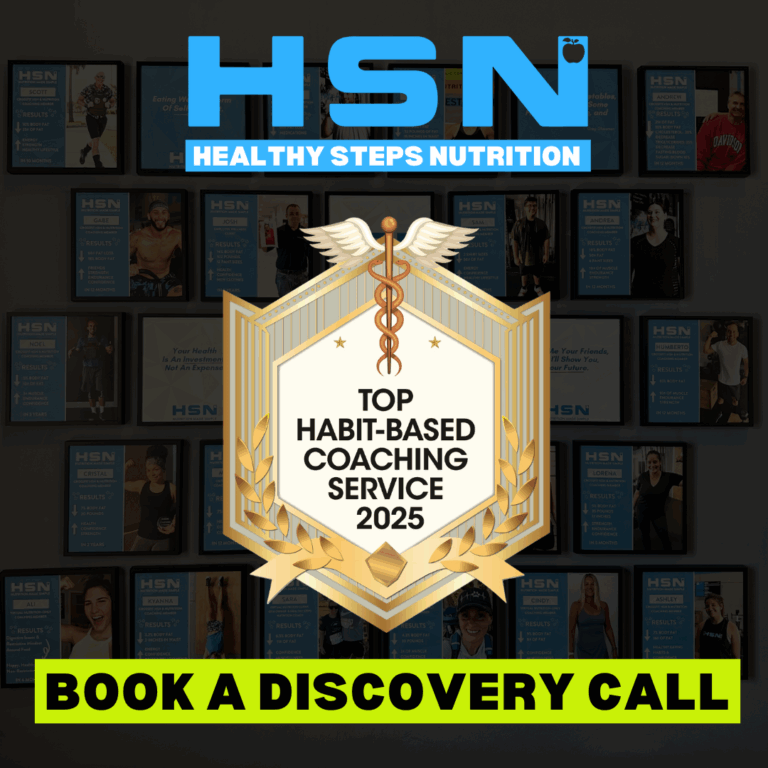The U.S. Department of Health and Human Services recently announced a major shift: medical schools and training programs must submit written plans by September 10 to expand their nutrition education. This is exciting news—but what does it actually mean for you, your family, and your health?
The reality is that nutrition has been largely absent from medical training. A 2024 study revealed a staggering gap: 75% of U.S. medical schools don’t require any clinical nutrition classes, and only 14% of residency programs make nutrition part of their core curriculum. That means most doctors graduate with little to no practical training in how to use food as medicine despite the fact that nutrition plays a massive role in preventing and managing chronic disease.
That’s why this update is so important and why at Healthy Steps Nutrition (HSN), we’ve been preparing for this moment for over a decade.
What The Research Says
Here’s the encouraging news: decades of research show that lifestyle change is far more powerful than most prescriptions when it comes to preventing chronic disease.
For example, large long-term studies like the Nurses’ Health Study and the Health Professionals Follow-up Study tracked hundreds of thousands of people for decades. In a pooled analysis of this data, researchers found that adopting just five low-risk lifestyle behaviors had profound effects on health outcomes:
Not smoking
Maintaining a healthy weight
Exercising regularly (30+ minutes daily)
Consuming moderate alcohol
Eating a high-quality diet
Women who adopted all five reduced their risk of heart disease by 80% and their risk of diabetes by over 90%. Whole foods, daily movement, quality sleep, and consistent healthy habits are the foundation of lifestyle medicine, fueling less risk and more longevity.
Despite this evidence, chronic diseases like diabetes, obesity, and heart disease are now the norm in the U.S. Nutrition is a proven way to reduce risk, but the gap has always been in education.
Doctors are expected to solve complex lifestyle issues in an average of less than 20 minutes with each patient. That’s simply not enough time to cover medications, labs, and provide meaningful nutrition and lifestyle support.
This is where health-focused coaches come in. Through the Global Health Project, we are helping bridge the gap between healthcare providers and coaches. HSN coaches are trained to deliver simple, habit-based strategies that align with medical care, giving patients the tools and accountability they need to actually change their behaviors long term.
What Happens In Reality
Just a few weeks ago, my husband Jason went to see a cardiologist. His cholesterol levels were well within the normal range. Yet, at the end of the visit, the doctor recommended he start on a statin, a medication that lowers cholesterol levels.
Of course, Jason’s first question was: “Why are you recommending this? What are the side effects?”
The response was vague, something along the lines of “it’s preventative.” No discussion of his eating habits. No questions about exercise. No exploration of family history. When pressed on side effects, the doctor brushed them off as minimal.
This experience is a powerful reminder of a bigger issue in healthcare: prescriptions are often the first line of defense, while lifestyle rarely gets the attention it deserves.
And Jason’s story isn’t unique.
And Jason’s story isn’t unique. An online survey of more than 1,800 adults over the age of 50 found that:
75% take a prescription medication regularly (with an even higher percentage in adults 65 and older).
Over 80% take at least two prescription drugs.
More than half take four or more medications.
African American and low-income individuals tend to take even more medications.
By the time most people reach their 50s and 60s, being on multiple prescriptions is seen as “normal.” But what if we shifted the focus toward nutrition, movement, and lifestyle first—and used medications only when absolutely necessary?
The Gap In Medical Practice
While medical schools are now being asked to expand nutrition education, many practicing physicians completed their training without this foundation. If that’s you, you’re not alone—and it’s not your fault. For decades, the medical curriculum has prioritized disease management and medications over lifestyle.
The good news? You don’t need to navigate this gap on your own. By partnering with health-focused nutrition coaches, you can connect your patients with the support they need to make sustainable lifestyle changes. Coaches provide the time, accountability, and behavior-change tools that are difficult to cover in a 20-minute visit.
Together, physicians and coaches can form a more effective care team, one that prioritizes prevention, whole foods, sleep, movement, and stress management alongside clinical care. This proactive, holistic approach can reduce the need for prescriptions, improve outcomes, and give patients the confidence to take ownership of their health.
Unfortunately, many of our clients come to us after receiving confusing or outdated advice. Here are a few examples:
“In order to lose weight, you need a low-protein diet.”
In reality, adequate protein is essential for preserving muscle mass, metabolism, and long-term health.“Don’t consume salt.”
A client with a history of elevated blood pressure was told to stop consuming salt. While excessive salt may be an issue, most people need to focus more on processed foods, hydration, and balanced whole foods—not simply eliminating salt. Lifestyle factors such as exercise and stress management also need to be addressed as solutions for high blood pressure.“CrossFit will get you hurt.”
The truth: not doing strength training increases your risk for chronic disease, sarcopenia, and low muscle mass, all of which are linked to higher mortality. Any exercise done poorly increases injury risk. At CrossFit HSN, our expert coaches ensure good form before increasing weight or intensity.“Red meat is bad for you.”
Actually, high-quality, lean red meat can be nutrient-dense, providing essential vitamins like B12 and iron—often at higher levels than poultry.
This isn’t to fault healthcare providers; it’s a reflection of limited training and time. And it’s exactly why stronger partnerships between physicians and coaches are so important.
What This Means for the Future of Healthcare
As nutrition becomes a formal part of medical education, here’s what we hope to see:
Partnerships, not silos. Physicians recognize that not all “nutrition experts” provide quality guidance. Instead, they partner with credentialed coaches who understand behavior change.
Lifestyle interventions before medications. For example, Family Medical and CrossFit 696 have created a partnership where everyone is required to obtain a body composition scan at CrossFit 696 before starting a GLP-1. These scans are then repeated every three months to ensure no significant loss of muscle mass. This model ensures that lifestyle and strength are prioritized alongside medical treatment.
Better testing. Tools like an InBody machine help measure muscle mass. Since low muscle mass increases risk for all-cause mortality, testing and preserving it should be a priority in preventive care.
These are the types of partnerships the Global Health Project is actively building, bringing together doctors, clinics, and coaches to prioritize lifestyle first, while supporting patients more comprehensively than either side could do alone.
What This Mean For You, The General Public
This movement is about more than medical school curriculum—it’s about giving people like you access to quality nutrition support that complements your medical care.
You deserve clear, evidence-based guidance on what to eat.
You deserve a partner who helps you implement changes that last.
You deserve a healthcare team that prioritizes nutrition and lifestyle interventions first.
That’s exactly what Healthy Steps Nutrition coaches do every day.
This creates a seamless bridge between traditional healthcare and the lifestyle interventions patients desperately need. Instead of leaving the exam room with vague advice like “eat better and exercise more,” your patients walk away with a clear plan, a certified coach, and a supportive community to guide them every step of the way.
Explore how providers across the country are already building these partnerships through The Global Health Project and learn how you can create your own bridge to better patient outcomes.
While HHS pushes medical schools to integrate nutrition training, we’re already here. The Global Health Project has connected healthcare providers with HSN coaches nationwide, creating a model where lifestyle change and medical care go hand in hand.
Because at the end of the day, lasting health doesn’t come from a prescription bottle—it comes from the small, consistent steps you take every day.
Editor’s Note & Dietitian’s Point of View
My hope is that this renewed focus on nutrition in medical education is not influenced by the food, beverage, or pharmaceutical industries but instead emphasizes whole foods first and limiting ultra-processed foods, which we know are driving today’s tsunami of chronic disease.
I also hope that a holistic approach is embraced one that recognizes how sleep, support systems, stress management, and exercise all influence health outcomes.
The goal should be a focus on preventative health, addressing root causes before someone develops chronic disease. We need a proactive model of care, not a reactive one.
As a dietitian, I can tell you from experience: when I went to school for nutrition, we were primarily trained to manage disease once it had already developed. What I didn’t learn and what I’ve since dedicated my career to is how to take a holistic, proactive approach to health. That’s the shift we need if we want to change the future of healthcare.






